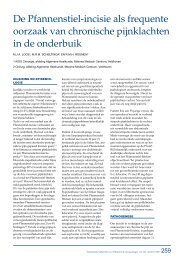Surgical management of chronic inguinal pain syndromes - Liespijn
Surgical management of chronic inguinal pain syndromes - Liespijn
Surgical management of chronic inguinal pain syndromes - Liespijn
Create successful ePaper yourself
Turn your PDF publications into a flip-book with our unique Google optimized e-Paper software.
INTRODUCTIONWorldwide millions <strong>of</strong> low transverse Pfannenstiel incisions are performed each year inobstetric and gynaecological practice. Ever since its introduction this approach has beena successful access path for lower abdominal surgery with an exceptionally low incisionalhernia rate (0-2%) and an aesthetically pleasing appearance (‘bikini cut’) 1,2 . Moreover,Pfannenstiel incisions are frequently used in laparoscopic procedures for removal <strong>of</strong>resected specimens 3,4 .The Pfannenstiel technique harbours one serious drawback being ‘nerve entrapment’ 2 .According to recent reports <strong>chronic</strong> <strong>pain</strong> is more commonly observed than previouslythought (12.3% - 33%) 2,5-8 . One study with a two year follow up reported that 8% <strong>of</strong>patients with a Pfannenstiel incision graded their <strong>pain</strong> as moderate or severe leadingFigure 1 Cutaneous innervation <strong>of</strong> lower abdomen 21 .This figure has appeared in the article by Ducic et al. Algorithm for treatment <strong>of</strong> postoperativeincisional groin <strong>pain</strong> after cesarean delivery or hysterectomy. Obstet Gynecol 2006; 108: 27-31.to limitations in daily functioning 5 . As laparoscopy with concomitant Pfannenstielincision is gaining popularity in general surgery, the incidence <strong>of</strong> nerve entrapmentswill probably rise as well.Treatment consists <strong>of</strong> nerve blocks or neurectomy. Aim <strong>of</strong> the present study was toassess long-term <strong>pain</strong> relief following these treatment modalities in patients sufferingfrom <strong>chronic</strong> <strong>pain</strong> due to Pfannenstiel-induced nerve entrapment.Anatomy and pathophysiology 5The cutaneous innervation <strong>of</strong> the lower abdomen is mainly supplied by two nerves, theiliohypogastric and the ilio<strong>inguinal</strong> nerves (figure 1). Originating from 12th thoracic and1st lumbar roots, they run on the anterior aspect <strong>of</strong> the lumbar quadrate muscle andpenetrate the transverse and internal oblique muscles. Endings <strong>of</strong> these nerves can befound subcutaneously or subfascially at the lateral margin <strong>of</strong> the abdominal rectusmuscles. If dissection during a Pfannenstiel incision is executed too laterally, thesenerves may be harmed potentially creating a neuroma 2 . Moreover, nerves may be traumatizeddue to perioperative retraction or following constricting sutures. Development<strong>of</strong> fibrotic tissues later on can also initiate nerve entrapment. Considerable anatomicvariability and overlapping cutaneous innervation areas complicate localisation andidentification <strong>of</strong> affected nerves and render clinical discrimination <strong>of</strong> iliohypogastricand ilio<strong>inguinal</strong> nerves exceedingly difficult 9,10 . In women the genit<strong>of</strong>emoral nerveaccompanies the round ligament and is nearly always unaffected during Pfannenstielsurgery. A neurectomy <strong>of</strong> the genital branch is therefore unnecessary. However concurrentipsilateral <strong>inguinal</strong> hernioplasty mandates a triple neurectomy according to Amid.Clinical presentation and diagnostic work-upPain may be reported immediately postoperatively or may develop over time. Neuropathic<strong>pain</strong> initiated by entrapped or damaged nerve tissue is characterized bylancinating, sharp or stabbing <strong>pain</strong> sensations at the incisional corners irradiating topubic area and/or upper leg. Hyperextension or twisting upper body movements caninduce <strong>pain</strong> by means <strong>of</strong> nerve traction or compression. Menstruation may increase<strong>pain</strong> sensations due to hormone-induced neurotransmitters. However, cutaneousendometriosis should also be considered 11 .At physical examination neurophysiological disorders such as hypoesthesia, hyperesthesiaor allodynia are <strong>of</strong>ten present. Remarkably, patients may not be aware <strong>of</strong> theseneurological abnormalities. Pressuring the incisional edge(s) at the abdominal rectusmargin may reveal a distinct trigger point. If active abdominal muscle contractionintensifies <strong>pain</strong> (positive Carnett’s sign), the <strong>pain</strong> is probably located in the abdominalwall. If nerve entrapment is likely, the diagnostic work-up should include a nerve blockusing a short-acting anaesthetic (e.g. lidocain) placed into the trigger point. Suchinjections ideally provide immediate <strong>pain</strong> relief and contribute to the diagnosis 5 .110 Chapter 8<strong>Surgical</strong> <strong>management</strong> <strong>of</strong> <strong>inguinal</strong> neuralgia after a low transverse Pfannenstiel incision 111





